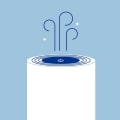Air purifiers are portable devices that combine an internal filter and a fan to remove unwanted particles from the air in a specific room. The purified air is then re-circulated to the room, repeating the process several times per hour to continuously improve indoor air quality. To comprehend how these devices work, it is essential to first define what an air filter is. An air filter is essentially a screen that fits in a compartment of the air conditioning system to clean the air that circulates through a house. Foam air filters have a high dirt-holding capacity, making them ideal for exhaust filters and filters for automotive intake systems.
According to the World Health Organization, exposure to air pollution in homes can lead to serious health problems, such as strokes, heart disease, chronic obstructive pulmonary disease (COPD) and lung cancer. The quality and quantity of filter media influence the size of the air particles that can be captured, the way they are captured, and the flow of air through the system. The filter medium is made of several layers of pleated polymer, fabric, or glass fibers that are spaced apart and held in a frame; all are housed in a container. Engine air filters must be replaced between 15,000 and 30,000 miles, depending on the type of vehicle and driving conditions. Exhaust filters are installed in ventilation systems to filter the air in an enclosed space before it is released into the environment. They are cheaper than pleated air filters, however, they have a shorter lifespan and require more frequent replacement or cleaning.
They consist of a single piece of synthetic fiber or mesh with tiny or microscopic perforations; this is stored and transported in a frame and installed in air filtering equipment. Carbon air filters are commonly used in air purifiers, extractor hoods (along with aluminum screens), bathroom fans, and microwaves. Research has shown that HEPA air purifiers can reduce smoke particles in the air, but not non-particulate nicotine or other gaseous components in smoke. These materials are designed or reinforced with another material to improve the efficiency of the filter and reduce its resistance to airflow. After taking apart some air purifiers and researching how they worked, it was realized that air purifiers don't have to be expensive. In conclusion, understanding how indoor air filters work is essential for maintaining good indoor air quality. Air filters capture airborne particles from the air before they enter our lungs.
They come in different types and sizes depending on their purpose. Foam filters have a high dirt-holding capacity while exhaust filters are cheaper but require more frequent replacement or cleaning. Carbon filters are commonly used in air purifiers while HEPA filters can reduce smoke particles from the air. Finally, materials used for filter media are designed or reinforced with another material to improve their efficiency. It is important to note that regular maintenance of your indoor air filter is essential for optimal performance.
Regularly replacing or cleaning your filter will ensure that your indoor environment remains free from pollutants and allergens. Additionally, it is important to choose an appropriate size filter for your space; too small a filter will not be able to capture all airborne particles while too large a filter will cause excessive airflow resistance. Overall, understanding how indoor air filters work is key for maintaining good indoor air quality. By selecting an appropriate size filter for your space and regularly replacing or cleaning it, you can ensure that your indoor environment remains free from pollutants and allergens.



